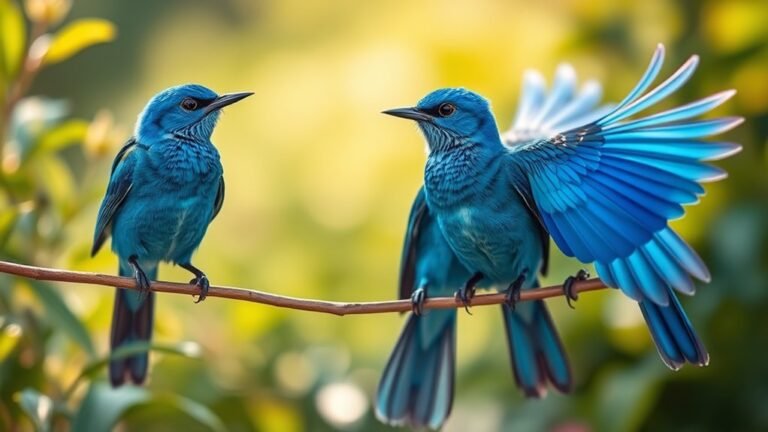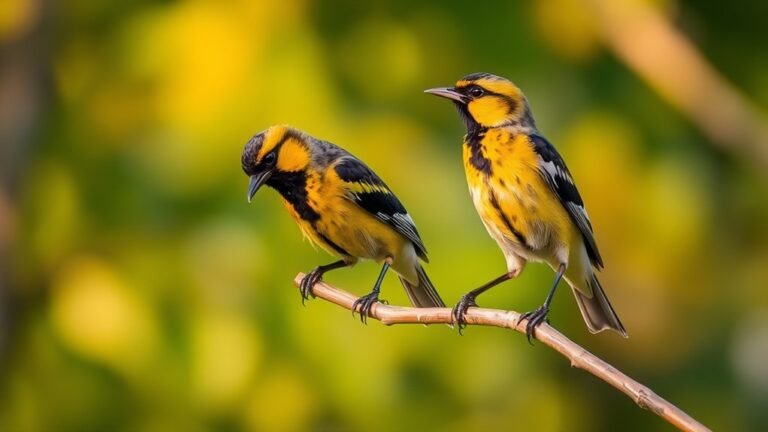Bird With Black and Yellow Feathers: Vibrant Avian Wonders
Birds with black and yellow feathers are striking and important in their ecosystems. Species such as the Baltimore Oriole and the Black-throated Green Warbler have special features that help them survive. Their bright colors attract mates and defend their territories. By studying these vibrant birds, we can learn more about their roles and the environments they inhabit.
Key Takeaways
- The Black-throated Green Warbler has vibrant black and yellow feathers. It lives in deciduous forests and attracts bird enthusiasts with its beautiful songs.
- The Baltimore Oriole features bright orange and black plumage. It migrates long distances and enjoys nectar-rich foods, captivating birdwatchers in North America.
- The Western Meadowlark displays vivid yellow and black feathers. It inhabits open grasslands, where males sing to attract mates and mark their territory.
- Golden Tanagers show brilliant gold and black feathers. They play an important role in tropical ecosystems by pollinating plants and spreading seeds.
- The Black-capped Chickadee is small yet bold. It has a black cap and yellow underside. This bird is known for its playful nature and distinctive "chick-a-dee-dee-dee" call.
The Golden Tanager: A Tropical Gem
The Golden Tanager features bright gold and black feathers that attract bird watchers worldwide. This stunning bird lives in tropical areas with abundant plants and vibrant surroundings.
You can find them moving through the treetops, where they enjoy environments rich in fruit and nectar.
Their diet mainly consists of berries, flowers, and insects, which fuels their active behavior. Watching how they feed reveals their important role in nature.
They help with pollination and spreading seeds. By learning about their living conditions and food habits, you connect with the ecosystem that supports these beautiful birds.
Enjoy observing the Golden Tanager and appreciate its significance in the tropical ecosystem.
Black-throated Green Warbler: Melodic Marvel
The Black-throated Green Warbler lives in deciduous forests. This bird has striking black and bright yellow feathers. Its melodic songs fill the trees, delighting birdwatchers and nature lovers.
You can observe three key behaviors of these warblers:
- Foraging: They hop from branch to branch, catching insects.
- Singing: They sing to mark their territory and attract mates.
- Migration: They travel long distances, showcasing their navigation skills.
Watching these warblers helps you appreciate their importance in nature.
Being involved in nature fosters connections among fellow enthusiasts.
Baltimore Oriole: A Bright Delight
The Baltimore Oriole is a striking bird known for its bright orange and black feathers. It captivates birdwatchers throughout North America.
These birds migrate thousands of miles. They travel from breeding grounds in eastern Canada to wintering locations in Central America. Watching their journey connects us to nature.
Baltimore Orioles have unique feeding habits. They enjoy nectar-rich foods and often visit hummingbird feeders. They also like ripe fruits, such as oranges and berries.
Western Meadowlark: The Song of the Prairie
When you hear the beautiful song of the Western Meadowlark across the prairies, it's hard not to appreciate this bird. It has bright yellow and black feathers and lives in open grasslands, which are crucial for its survival.
Observing the Western Meadowlark shows interesting behaviors:
- Singing: Male Meadowlarks sing to mark their territory and attract females. Their singing highlights their musical talent.
- Finding Food: They search for insects and seeds on the ground, showing their important role in the ecosystem.
- Building Nests: They construct nests in tall grass, which helps to hide them from predators.
Each part of the Western Meadowlark's life connects us to the beauty of the prairie and its lively creatures.
Black-capped Chickadee: A Bold Presence
The Black-capped Chickadee is a small bird with a black cap and a yellow underside. It's common in forests and backyards. This bird is fearless and often approaches people without fear. You can see it moving playfully from branch to branch, making its recognizable "chick-a-dee-dee-dee" call.
Chickadees are adaptable feeders. They eat seeds and suet from bird feeders. They also hide food to eat later, showing their intelligence.
Watching these birds can help you understand their social behavior and survival strategies. This connection to nature can enhance your personal experience and sense of belonging.
Common Yellowthroat: The Master of Camouflage
The Common Yellowthroat is a fascinating bird commonly found in wetlands and thick vegetation. It excels at blending into its environment, which aids in its survival. This bird prefers several natural habitats:
- Marshes with dense plants.
- Shady woodlands and edges.
- Areas with plenty of grasses and low shrubs.
This ability to camouflage helps the Common Yellowthroat avoid predators while searching for food, which mainly consists of insects, spiders, and seeds.
You can often spot these birds moving quickly through dense brush, and their distinctive calls fill the air. Watching them in their natural settings reveals their behavior and survival skills.
This clever balancing act between being hidden and visible showcases the beauty of nature, allowing this small bird to thrive despite challenges.
Frequently Asked Questions
How Can I Attract Black and Yellow Feathered Birds to My Yard?
To attract black and yellow feathered birds to your yard, set up bird feeders with seeds they like. Use sunflower seeds and nyjer seeds, which are popular among these birds. Plant native flowers and shrubs to provide food and shelter. This will create a friendly environment for them. Keep your yard clean and ensure water is available for drinking and bathing. With these simple steps, you can enjoy the beauty of black and yellow birds visiting your space.
What Do Black and Yellow Feathered Birds Eat?
Black and yellow feathered birds eat seeds, fruits, and nectar. They prefer sunflower seeds, berries, and sugary liquids. You can attract these colorful birds to your yard by providing these food sources. Observing their feeding habits can be enjoyable and rewarding. Create a welcoming space with feeders and plants that offer these foods. This will help ensure they visit often and brighten your surroundings with their presence.
Where Can I Find Information on Bird-Watching Events?
To find bird-watching events, check birding apps and local clubs. These resources provide up-to-date information on events in your area. Joining local clubs also allows you to meet other bird-watchers, share experiences, and enjoy the community. Bird-watching can be a rewarding hobby, and connecting with others enhances the experience.
Are There Conservation Efforts for These Bird Species?
Yes, many conservation efforts work on protecting bird species and their habitats. These initiatives focus on preserving environments where birds live and thrive. You can help by joining volunteer programs, making donations, or promoting sustainable practices in your community to support these beautiful birds. Every action can make a difference in their survival.
How Can I Identify Different Black and Yellow Feathered Birds?
To identify black and yellow feathered birds, observe their size, shape, and behavior. Note where you find them, as different species prefer different habitats. Use field guides to compare their features for correct identification. Joining local birdwatching groups can enhance your experience and allow you to share discoveries with fellow enthusiasts. Enjoy the process of learning and connecting with nature as you observe these birds.

Kashvi is a passionate bird enthusiast and nature lover who has been fascinated by the world of birds for years. With a keen eye for detail and a love for learning, Kashvi is dedicated to sharing her knowledge and insights with fellow bird enthusiasts on Avian Enthusiasts. Through her engaging and informative articles, Kashvi aims to inspire others to join her in exploring the fascinating world of birds and to promote a deeper appreciation for these incredible creatures.







